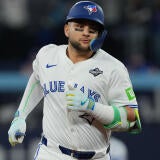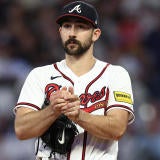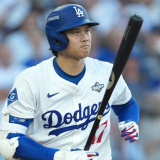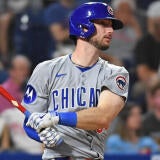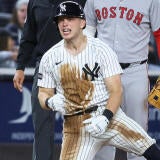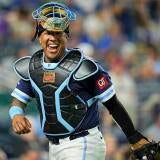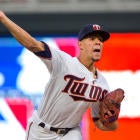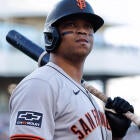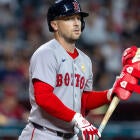Fantasy Baseball: These five might be aces, led by Tyler Glasnow, Jose Berrios
Heath Cummings takes a look at five young pitchers who may just be making their ace turn.
For more Fantasy baseball insights, and to keep up with all the latest news, roster trends and more throughout the season, subscribe to Fantasy Baseball Today now on iTunes, Stitcher or Spotify. You can find us on YouTube now, with full episodes and clips available every Monday through Friday.
It's good to be cautious in evaluating early-season success. It's a very wise thing to not make bold proclamations about players in April.
But it's also not very fun.
Let's have some fun.
Below are five young pitchers with ace potential who actually have looked like aces early in the season. Instead of talking about their most-likely outcomes or coming regression, let's take a look at their reasonable upside and embrace their excellence
Jose Berrios came into the season with almost 400 innings of Major League experience and an ERA over four, so he may seem like the least likely to keep this hot streak going. But I'm not so sure.
In 2018, Berrios had 12 outings where he went at least seven innings and gave up fewer than two runs. He did it at home and on the road. He did it against bad offenses like the Royals and White Sox, but he also had two of his most dominant performances against the Cardinals and Rangers. Berrios flashed ace potential in just about every situation you could imagine.
Of course, he also had eight starts where he didn't even finish five innings. That's the part that has to change if Berrios is going to be a Fantasy ace.
One thing that has changed so far for Berrios is his pitch usage. His curveball was his best pitch in 2018, generating a 38.8% whiff rate and a .259 wOBA against, per BaseballSavant.com. Wisely, Berrios has thrown that pitch even more often in 2019. The 8% increase in curveball use has come largely at the expense on his sinker, which was his worst pitch by whiff rate in 2018.
One other change with Berrios has been with the location of his changeup. He's not throwing the pitch much more often than he did in 2018, but he's throwing the pitch for strikes more often, specifically on the edge of the strike zone. In 2018 73% of his changeups were thrown out side of the strike zone. That percentage has plummeted to 48% so far in 2019. It's only 30 pitches, so we don't know what it means yet, but that pitch generates a 30 percent whiff rate for Berrios and is his best ground ball pitch. It's a good thing for him if batters swing at it more often. Berrios talked about increasing his changeup usage after Opening Day and this early success with the pitch should only encourage that.
The realistic upside: The sky is the limit for Berrios in points leagues if he can diversify his arsenal and eliminate those blowup outings. He's averaged nearly seven innings per start in 2019 and the Twins haven't yet allowed him to top 100 pitches. He could approach 220 innings with at least that many strikeouts, an ERA in the low-3.00s and a sub-1.10 WHIP. The best comp would be the pitcher he bested on Opening Day, Corey Kluber.
Shane Bieber doesn't have the track record Berrios does, but like Berrios, he did enter the year with a career ERA north of 4.00. In his rookie season he looked very much like a pitcher getting worse results than he deserved and so far in 2019 that's looked correct.
In Bieber's three 2019 starts he's struck out 20 batters in 19 innings, posting a 0.79 WHIP and 1.42 ERA. Part of the success is his luck going the other way, as evidenced by his .192 BABIP-against and 84.3% strand rate. In other word's not as bad as he was in 2018 and he's not as good as he's been in 2019. So how good is he?
In 135 major league innings Bieber owns a 3.14 FIP and a 3.51 SIERA. He has averaged 5.86 innings per start and better than a strikeout per inning with just 29 walks. Over a full season that looks like a low-3.00s ERA over 190 innings with a low WHIP and close to 200 strikeouts. Not quite an ace, but that's just what he's done, not what he could be.
Early in 2019 Bieber has made a couple of changes. Like Berrios, he's increased the usage of his best pitch (slider) from 22% to 31% and he's reduced the usage of his fastball from 57% to 47%. That alone helps, because his slider generates a whiff rate over 40% while his fastball has struggled to get even a third of that. But the second change may be more important: Bieber threw 53.6% of his pitches in the strike zone last year. He's cut that to 45.6% this year.
For a pitcher with control as good as Bieber's there's a danger in throwing too many strikes. Especially too many strikes right down the middle. In 2018 Baseball Savant had 9.0% of Bieber's pitches in the 'Meatball' part of the strike zone. So far in 2019 he's halved that rate.
The realistic upside: Bieber's best case scenario looks very much like Zack Greinke. Greinke has remarkable control but spends as little time in the strike zone as possible. In 2018 he threw the seventh lowest percentage of his pitches in the zone and also had the seventh lowest walk rate. Neither has an explosive fastball, but a good enough pitch mix and control to make up for it.
Tyler Glasnow has been the No. 1 starting pitcher in CBS points leagues and it's not just because he's 4-0. Okay, it's mostly because of his record, but he's been awesome regardless.
What has been most surprising so far has been Glasnow's control and efficiency. In each of his first three major league seasons he had a walk rate over 10%. So far in 2019 that has fallen to 3.3%. That's helped him get through six innings in three of his four starts without topping 90 pitches once. He's done this both by increasing the percentage of pitches he throws for strikes but also the percentage of balls batters chase. That's a pretty good combination.
Glasnow is still basically a two-pitch pitcher, with 92% of his pitches being fastballs or curveballs. But he has increased the curveball usage and the 14-mph difference between the two may mean he doesn't necessarily need a third.
The realistic upside: If Glasnow can be this efficient while continuing to get ground balls and swings and misses at the same rate, the only limit on his upside will be how many innings the Rays let him throw. His career-high is 155.1 in 2017, but he only threw 111.2 last year. A realistic upside should probably be around 180 innings. But that's 180 innings of an ERA quite possibly below three and a WHIP that may be close to 1.00. Glasnow could absolutely be an ace in a categories league.
In his last 21 starts German Marquez has struck out 171 hitters and walked just just 28 in 140 innings. So forgive me if you've already decided Marquez is an ace and think it's insulting I've included him in this group.
His breakout in 2018 coincided with a drop in his four-seam usage and an increase in his off speed stuff. The slider was the most devastating, but all his pitches seemed to get more effective when he diversified his offerings and he posted a whiff rate over 30% for the last two months of the season.
Of course, the elephant in the room with Marquez is Coors Field. We've seen that once already when he got lit up by the Braves in his lone home start of 2019. Of course, he followed that up with a one-hitter against the Giants and has a 2.00 ERA overall, so it's fair to question how much it matters.
It matters. In 2018 his ERA was 1.79 higher at home and for his career it's 1.22 higher. The reason for optimism? His final seven home starts of 2018 were spectacular. Whether that sticks will determine whether Marquez sticks as an ace.
The realistic upside: If Marquez is as good at home as he was in those seven starts he could be the best pitcher in Fantasy this year. But I'm not sure how realistic that is, not yet. Still, he could pitch to a 3.75 ERA at home and be a low-3.00s guy for the season. With 200-plus innings and his 10.3 K/9 since the start of 2018, he'd absolutely be an ace.
Luis Castillo has teased us with his talent more than once. I'd argue analysts have spent as much time parsing his game logs as any young pitcher in baseball. There was the 12-game stretch in 2017 with a 2.84 ERA. The 2.43 ERA in the middle of 2018. Or was it the spectacular September in 2018? Well, now it's the start to 2019.
Castillo has yet to give up more than two runs in any of his first four starts. He's struck out 32 batters in 24.1 innings. His ground ball rate has soared back up to 58.7%. It sure looks like it's all happening ... again.
It's easy to remember why so many people believe in times like these. Castillo has a 95-mph heater and one of the best changeups in all of baseball. He gets a ton of ground balls, has an above average whiff rate, and doesn't walk too many batters. It's everything we look for.
So far in 2019 Castillo has followed the crowd, throwing his fastball just a third of the time. Like Bieber, he's also thrown fewer strikes and cut his 'meatball%' to 4.1%. And it's worked. His whiff rate (43%) is the highest of his career and he's yet to allow a barrel.
The realistic upside: We've seen Castillo's upside a number of times, just never consistently. That upside looks like one of the best pitchers in baseball on a per-inning basis. A sub-3.00 ERA, a WHIP around 1.00 and more strikeouts than innings pitched. He won't likely hit 200 innings and his win potential is hampered by the team around him and his innings, but 190 innings and 14 wins seem reasonable. In Fantasy that might look like a more-believable version of the season Mike Foltynewicz just had. Or Aaron Nola on a worse team with 20 fewer innings.










